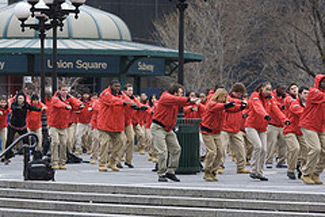|
|
In the United Kingdom, there have been two recent research projects into the spirituality of 14 to 25-year-olds.1 Both were based on personal interviews with groups of young people. Making Sense of Generation Y was commissioned under the assumption that there is a rise in interest in spirituality among young people. The goal was to try to “tease out” this spiritual interest through discussions of various expressions of popular culture.
The approach to “teasing out” spiritual seekers was subtle, using indirect lures rather than a direct approach. The conclusion, which was initially difficult for the researchers, was that the assumption was wrong: “We argue that the allegedly widespread phenomenon of a growth in eclectic spiritual seeking among young people is illusory.”2 Researchers concluded that young people are not interested in spiritual things, but rather that it is a story the Church likes to tell itself. Their interviewees' worldview, what the authors describe as a “happy midi narrative,” revolves around young people and their friends being happy together in the here and now and overcoming problems through those friendships toward that end.
Buried Spirituality, published a year earlier, took a much more direct approach. Phil Rankin sought groups of young people and used two direct questions out of which conversation grew: Would you perceive yourself to be spiritual? and What do you think the word “spiritual” means? His findings were very different. Young people were open and willing to engage in conversation around these questions. He concluded that young people are asking spiritual questions, are keen to reflect upon spirituality, and many are having spiritual experiences. However, this spirituality is often buried within the pressures of everyday life and not always named because young people struggle to find a language with which to articulate these experiences.
Both reports also commented on young peoples’ perceptions of church, and here they occupy some common ground which makes for pretty uncomfortable reading. “Boring,” “judgmental,” “hypocritical,” “uncool,” and “culturally alien” come out in Generation Y,3 while Rankin can only summarise the views in the sentence, “Church is s**t.” This may seem shocking; however, he argues strongly that this is the most honest statement: “The vast majority of young people do view the church as irrelevant, controlling, etc., but it is [this] description that seems to combine these negative observations.”4 ![]()
So even if there is openness to spirituality which seems to depend upon where or how you look, the church is not the place young people are looking to find it. According to Lesslie Newbigin,
If the gospel is to be understood….if it is to be received as something which communicates the truth about the real human situation, if it is as we say “to make sense,” it has to be communicated in the language of those to whom it is addressed and it has to be clothed in symbols which are meaningful to them. And since the gospel does not come as a disembodied message, but as the message of a community which claims to live by it and which invites others to adhere to it, the community's life must be so ordered that “it makes sense” to those who are so invited. It must, as we say, “come alive.” Those to whom it is addressed must be able to say, “Yes, I see.”5
Clearly, for the majority of young people, at least in the UK, when they look at the Church, it doesn’t make sense and they don’t see!
“Church on the Edge” is a project in Devon and Somerset in rural areas in the UK. The thinking behind this project is that a typical church in a village has an ageing congregation. Expecting young people to join is simply unrealistic. Therefore, in terms of mission, a new strategy is needed. With the blessing and permission of more traditional churches, church on the edge will seek to engage with young people outside of the orbit of church to share Christ. The goal is not to get people in pews in existing churches; rather, it is to develop a new expression of Christian community in specific cultures.
Go with “the Flow”
In Chard, for example, Richard Passmore6 has been doing detached/relational work among skateboarders who have no Christian background. He is using a framework for developing church on the edge that develops from a contacting community through stages of being a growing, connected, and exploring community to a practicing ecclesial community. In twelve months, deep relationships have been formed and the group has been on a couple of residential pilgrimage weekends. Additionally, in discussions around God and spirituality, Richard has suggested, in conversation with the skaters, that “Flow” might be their language for God.
|
|
This has really taken off and Richard has reworked a few scriptures and parables using Flow (i.e., “In the beginning was the Flow.”). His inspiration comes from stories of cross-cultural mission where the starting point is to try and see what God is doing and join in. Part of this involves naming God in the culture and developing a set of mission instincts to respond and improvise in terms of what God is doing. Many of the skaters have decided to “go with the Flow” and develop church on the edge together. Richard's vision is of a community that has a missional DNA at its core that will then enable people to live out mission as part of their mission discipleship.
Setting Sail
Mark Berry7 is a mission leader in Telford, UK. He and his wife Louise were tasked jointly by the diocese of Lichfield and by the Church Mission Society (CMS) to reach out to young adults in Telford. They have taken the story of Saint Brendan as a guiding narrative. Brendan was a Celtic saint who knelt down on the beach on the West coast of Ireland and prayed. He then got into a small leather boat with a band of monks to set sail where the wind of the Spirit would blow them. They travelled for nine years sharing Christ where the Spirit took them.
A small community has gathered with Mark to share a meal and break bread every Thursday. They seek God as to where they should be setting sail in their community. This has led, for example, to involvement in Telford football clubs, leading sessions on spirituality at the local college, holding pilgrimage walks for families, and running stands at the local “mind, body, and spirit” fair to share Christ and pray with people. The community talks about a missional DNA that Mark seeks to guard at the core of what they do. ![]()
Missional Imagination
If we are to reach Europe’s youth, it is precisely this sort of missional imagination that we need to cultivate and encourage in leaders. Insights (both good and bad) from cross-cultural mission hold the clues as to how we go about mission in our own cultures, and not just overseas. To state the obvious, Europe is a mission context (or, in fact, many contexts).
What might the gospel look like in the postmodern soils of Europe? And what sort of indigenous Christian communities might grow that are birthed out of a missional imagination rather than a colonized one? I am hopeful about the returning emphasis in the churches in Europe toward mission and the recovery of a missional imagination. This is why those of us involved with the CMS are investing in the training and development of mission leaders and in birthing mission communities shaped by mission spirituality at their heart.
Returning to the research among “secular” youth that I began with, both research pieces make some good suggestions in terms of response. Graham Cray,8 in his response to the findings of Generation Y, says that church must re-connect with culture, get involved with incarnational church planting, and engage patiently in prior mission, building relationships, and patiently sowing seeds of the gospel where people are at, rather than expecting them to “come to us.” This will require a shift from viewing church as a refuge from the wider culture to a focus on mission discipleship being core to what the church is about. Rankin suggests that the Church (in spite of perceptions) is well placed if she can create spaces for young people to explore spiritual questions and uncover that which is “buried,” and if we can be people who will walk alongside them on their journeys.
In these ways, perhaps young people, as Newbigin suggests, will be afforded the opportunity to say that the gospel has come alive, makes sense, and yes, they see.
Endnotes
1. Savage, Sara, Bob Mayo, Sylvia Collins-Mayo, and Graham Cray. 2006. Making Sense of Generation Y. London: Church House Publishing; Rankin, Phil. 2005. Buried Spirituality. Salisbury, UK: Sarum College Press.
2. Savage, et al. 136.
3. Ibid. 13-16.
4. Rankin. 56-57.
5. Newbigin, Lesslie. 1989. The Gospel in a Pluralist Society. London: SPCK, 141.
6. The reflections on mission and the journey with the skaters is documented at: www.sundaypapers.org.uk/?cat=22.
7. Mark blogs at: http://markjberry.blogs.com/way_out_west/.
8. The last two chapters of Making Sense of Generation Y are Graham Cray’s response.



